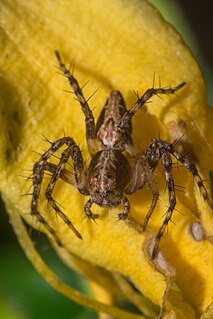
Wolf spiders are members of the family Lycosidae, from the Ancient Greek word "λύκος" meaning "wolf". They are robust and agile hunters with excellent eyesight. They live mostly in solitude and hunt alone, and do not spin webs. Some are opportunistic hunters pouncing upon prey as they find it or even chasing it over short distances. Some wait for passing prey in or near the mouth of a burrow.

The Pholcidae are a family of araneomorph spiders. The family contains over 1,800 pholcids, including those commonly known as the marbled cellar spider , daddy long-legs spider, granddaddy long-legs spider, carpenter spider, daddy long-legger, vibrating spider, gyrating spider, long daddy, and skull spider. The family, first described by Carl Ludwig Koch in 1850, is divided into 94 genera.

The epigyne or epigynum is the external genital structure of female spiders. As the epigyne varies greatly in form in different species, even in closely related ones, it often provides the most distinctive characteristic for recognizing species. It consists of a small, hardened portion of the exoskeleton located on the underside of the abdomen, in front of the epigastric furrow and between the epigastric plates.

Geolycosa is a genus of wolf spiders first described in 1904.
Geolycosa rafaelana is a spider in the genus Geolycosa, in the family Lycosidae . It is found in the USA.
Geolycosa pikei is a species of wolf spider in the family Lycosidae from the United States. It can blend into sand, which it also burrows in. The spider can heal its wounds quickly.
Geolycosa micanopy is a species of wolf spider in the family Lycosidae. It is found in the United States.
Geolycosa gosoga is a species of wolf spider in the family Lycosidae. It is found in the United States.
Geolycosa missouriensis is a species of wolf spider in the family Lycosidae. It is found in the United States and Canada.
Geolycosa ornatipes is a species of wolf spider in the family Lycosidae. It is found in the United States.
Geolycosa riograndae is a species of wolf spider in the family Lycosidae. It is found in the United States.
Geolycosa wrighti is a species of wolf spider in the family Lycosidae. It is found in the United States and Canada.
Geolycosa turricola is a species of wolf spider in the family Lycosidae. It is found in the United States.
Geolycosa xera, or Mccrone's burrowing wolf spider, is a species of wolf spider (Lycosidae) endemic to Florida in the United States.
Geolycosa fatifera is a species of wolf spider in the family Lycosidae. It is found in the United States.

Neotama mexicana, also known as the long-spinneret spider or Mexican two-tailed spider, is a species of tree trunk spider in the family Hersiliidae. It is found in a range from the United States to Peru and Guyana.
Xysticus emertoni, or Emerton's crab spider, is a species of crab spider in the family Thomisidae. It is found in the United States, Canada, Slovakia, Russia, and a range from Central Asia to China.
Geolycosa hubbelli is a species of wolf spider in the family Lycosidae. It is found in the United States.

Oxyopes scalaris, the western lynx spider, is a species of lynx spider in the family Oxyopidae. It is found in North America.





